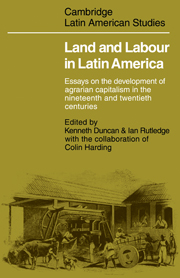 Land and Labourin Latin America
Land and Labourin Latin America Book contents
- Frontmatter
- Contents
- List of tables
- List of figures
- List of maps
- Acknowledgements
- 1 Introduction: patterns of agrarian capitalism in Latin America
- PART I THE TRANSITION FROM TRADITIONAL HACIENDA TO CAPITALIST ESTATE
- 2 Hacienda profits and tenant farming in the Mexican Bajío, 1700–1860
- 3 Landlord, labourer, and tenant in San Luis Potosí, northern Mexico, 1822–1910
- 4 Land and labour in rural Chile, 1850–1935
- 5 The development of the Chilean hacienda system, 1850–1973
- 6 Relations of production in Andean haciendas: Peru
- 7 The formation of the coffee estate in nineteenth-century Costa Rica
- PART II THE DEVELOPMENT OF A PLANTATION ECONOMY WITH LABOUR RECRUITMENT FROM HIGHLAND PEASANT COMMUNITIES
- PART III THE DEVELOPMENT OF COMMERCIAL AGRICULTURE USING EUROPEAN IMMIGRANT LABOUR
- PART IV THE TRANSITION FROM SLAVE PLANTATION TO CAPITALIST PLANTATION
- PART V POSTSCRIPT
- Glossary of Spanish and Portuguese terms used in the text
- Weights and measures
- Notes on contributors
- Indexes Subjects
- Authors
5 - The development of the Chilean hacienda system, 1850–1973
Published online by Cambridge University Press: 07 May 2010
- Frontmatter
- Contents
- List of tables
- List of figures
- List of maps
- Acknowledgements
- 1 Introduction: patterns of agrarian capitalism in Latin America
- PART I THE TRANSITION FROM TRADITIONAL HACIENDA TO CAPITALIST ESTATE
- 2 Hacienda profits and tenant farming in the Mexican Bajío, 1700–1860
- 3 Landlord, labourer, and tenant in San Luis Potosí, northern Mexico, 1822–1910
- 4 Land and labour in rural Chile, 1850–1935
- 5 The development of the Chilean hacienda system, 1850–1973
- 6 Relations of production in Andean haciendas: Peru
- 7 The formation of the coffee estate in nineteenth-century Costa Rica
- PART II THE DEVELOPMENT OF A PLANTATION ECONOMY WITH LABOUR RECRUITMENT FROM HIGHLAND PEASANT COMMUNITIES
- PART III THE DEVELOPMENT OF COMMERCIAL AGRICULTURE USING EUROPEAN IMMIGRANT LABOUR
- PART IV THE TRANSITION FROM SLAVE PLANTATION TO CAPITALIST PLANTATION
- PART V POSTSCRIPT
- Glossary of Spanish and Portuguese terms used in the text
- Weights and measures
- Notes on contributors
- Indexes Subjects
- Authors
Summary
The nature of the hacienda system: the conflict between landlord and peasant enterprises
In this paper I shall attempt to explain the changes in the Chilean hacienda system which has dominated rural society since colonial times. Although the hacienda system has until recently retained many of its traditional features, largely by maintaining its economic, social, and political predominance in the countryside, nonetheless it has experienced cumulative changes which have gradually undermined the unity of the hacienda as a system, transforming it from a large multi-farm estate, characterized by a complex of traditional landlord–peasant relationships, to a single-farm estate, characterized by farm manager–wage labour relationships. The pressures for change have come from sources largely external to the hacienda system. Among the important causes of the transformation of the Chilean hacienda system must be mentioned the changes in the market (both internal and external), the growth of the urban population, and the increasing radicalization and political organization of the urban working class and later of the peasantry. This analysis will focus on the changes which these factors provoked in the hacienda system, particularly in its labour structure.
Perhaps I should spare a few lines explaining my conceptual approach to the problem, especially in the hope that other analysts might find it useful when studying landlord–peasant relationships in regions dominated by the large landed estate. I shall adopt the ‘multi-enterprise approach’ first presented by Rafael Baraona in his study on the nature of the hacienda in the Ecuadorean Sierra. The multi-enterprise approach views the hacienda system as a conflicting unity between two types of agricultural enterprise: the landlord and the peasant.
- Type
- Chapter
- Information
- Land and Labourin Latin AmericaEssays on the Development of Agrarian Capitalism in the nineteenth and twentieth centuries, pp. 103 - 140Publisher: Cambridge University PressPrint publication year: 1978
- 4
- Cited by


